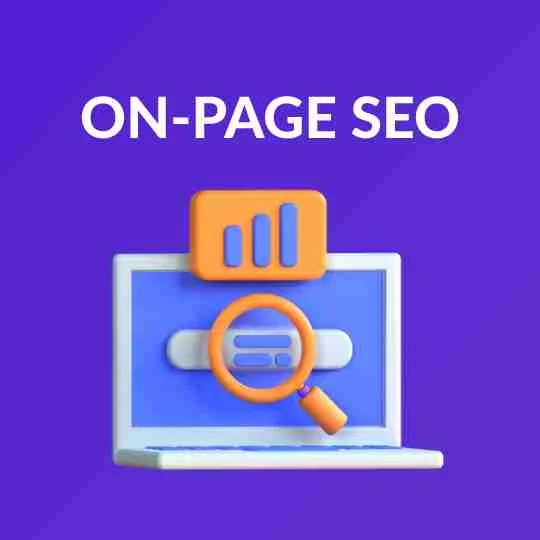
ON-PAGE SEO
Attract Traffic - More Sales - Increase Revenue - Customized Ecommerce SEO Services

A successful Search Engine Optimization (SEO) strategy practice starts with your own website. There are numerous elements on a site that can make or break your ranking potential. Do you have knowledge of those? Are they optimized right?
When Google isn’t able to find your site worthy, or isn’t recommending it to users, you need effective On-Page SEO implementation.
Contact the Leading Digital Marketing Company
Redefine Your Site’s Online Presence with Esearch Logix’s On-Page SEO Services
Google has updated its concept of understanding site’s content and value so many over the last few years. This underlines the importance of keeping up with the best and updated On-page SEO tactics.
On-page SEO, or as it is also known as on-site SEO, is no magic, and there is no shortcut to success here. Our creative and advanced on-page SEO strategies are compiled to bring your website, webpage, blog, landing page or micro-site onto the top of search result rankings.
We are experts in creating content that users and search engines want to see – a key aspect of on-page SEO strategies
However, we top that up by optimizing all the essential on-site elements to give your online presence the required boost to rank and attract inbound traffic.
Speak to Our On-Page SEO Strategist Now!
- Experienced and Certified SEO Experts
- 150% Revenue Increase with Our On-Page SEO Services
- 100% White-Hat SEO Techniques with Proven #1 Page Ranking on Google
What is On-page SEO?
On-Page SEO is the technique of optimizing a website for search engines and users, to improve its search engine result pages (SERPs) ranking and gain organic traffic.
There are several on-page SEO practices for optimizing webpages and blogs that include page content, title tags, heading tags, keyword optimization, meta text, internal links, URLs, images, page speed optimization and more.
WHY IS ON-PAGE SEO IMPORTANT?
To rank your page in search results, Google looks at the signals that define how relevant your webpage or site is corresponding to a particular search query. If your page contains the same keywords as the search query, the page is more likely to be relevant. Thus it improves the chances of the page to rank higher in search results.
Google and other search engines also look at other factors that affect how searchers are interacting with your site. This includes page load speed, uniqueness and value of content, and much more. All these optimizations can be done with effective on-page SEO practices only. This process does take time but once you have implemented strong on-page SEO strategy, it will improve your ranking and inbound traffic considerably.
WHAT KEY FACTORS ON-PAGE SEO STRATEGY SHOULD FOCUS ON?
On-Page or On-Site SEO includes all the practices done within a website, and over which you have full control. However, it isn’t an easy task. An effective on-page SEO strategy lays the foundation for a quality off-page SEO campaign as well, as no one would want to link to a site that has scrappy content or if the site isn’t working properly.
There are several ranking factors that should be in the mix of things for a successful On-page SEO strategy:
- Page Title Tags – Use heading tag, H1, as the title tag, with a 60 to 80 character limit. This is the SEO title that tells what the page is about and is shown in the search results.
- Heading Tags – Use other heading tags, from H2 to H6 for the sub-headings on the page.
- Meta Tags – Meta title, meta description, meta robots are all key factors that tell search engine crawlers about the page info.
- Schema Tags–This is kind of micro data that helps search engines to extract the content on the web pages to present more relevant and better information in search results as rich snippets.
- Webpage Content – The uniqueness and quality of the content is a big on-page SEO factor. The content should be in a well-defined structure, is relevant, rich in formation, keyword optimized, and updated.
- Keyword Use – Keywords should be used in page title, meta tags, in page summary, and conclusion. The keyword density should be 2-3%, and you should use both, short-tail and long-tail keywords.
- Text Format – Highlight important words or sentences in bold. Important keywords in answers can be highlighted in italic, and blockquotes help to highlight key points. Use ordered list form and bullets to segment the content wherever needful.
- Image Optimization–image should be named properly without spaces, and must be accompanied with an alt tag. Use image title tags, caption, and have the image optimized so that the page loads fast. Use the right file type (.jpg format is more SEO-friendly).
- URL Structure – Use the right format for the URL – all characters should be in lower case, use’/’ as page separator, use ‘-‘ to separate words, and keep the URL as short as possible.
- Links – Internal linking helps people and search engines navigate to other pages/blogs containing related information. External links from high-authority sites also help to build domain authority.
- Site Accessibility–XML sitemaps are search engine friendly sitemaps and help to alleviate crawling issues of the site or blog. Also, make site navigation easy and straightforward, along with a breadcrumb format.
- Additional Media – Use of additional media forms like images, infographics, videos help bring more value to the information you present, and it improves search appearance.
- User Experience – You need to have a well-defined UI and UX implementation that improves user experience, enhances user engagement and boosts site ranking probability.
- Site Speed – How fast the site load is a big ranking factor for search engines. It improves user experience and reduces bounce rate. Optimize each element of webpages so that it loads fast.
WHAT IS E-A-T? HOW IT IMPACTS ON-PAGE SEO?
With E-A-T, Google wants to be clear that it will reward sites that produce high quality, people-first content, crafted by an expert and are trustworthy, and will punish sites that generate low quality, unhelpful content.
- ‘E’ stands for Expertise–As a content creator you have to demonstrate your expertise in a particular niche. This can be industry or field-wise expertise, or can be ‘everyday expertise’ as well, meaning life or experience expertise.
- ‘A’ stands for Authoritativeness – Authority is all about your reputation in the industry circles. It denotes how credible you are as a knowledge source in the field, and how much valuable others consider you citing as a source of info.
- ‘T’ stands for Trustworthiness – It takes time and effort to earn the trust of users, target audience and search engines. And as you gain trust more and more, the better your site will be trusted by all, including Google, to display and rank on relevant search queries.
HOW E-A-T IS IMPORTANT FOR ON-PAGE SEO?
What Google has been telling us, site-owners, for decades? Create great quality content to appear on top of search results.
Well, no longer we can reverse-engineer how Google algorithms work. There is no short-cut to success here. All we need to do what Google has been saying. And with implementation of E-A-T concept, it has stamped its statement boldly.
You follow E-A-T and you get your site land on the top of the rankings in search results. You need to deliver value to the users, create content that speaks to them, provide them solution, asserts your knowledge, expertise in the field, and Google will definitely put you at the forefront.
E-A-T applies to all types of sites, and it includes your site as well.
Therefore, E-A-T is critical when you want to present your website content. And it starts with on-page SEO.
HOW TO CREATE WEBSITE CONTENT ACCORDING TO E-A-T GUIDELINES?
.Identify the content creators with a detailed bio, crafted with a journalistic professionalism.
- The site should provide visitors easy access to business contact info.
- Replace or remove the low-quality, less relevant, outdated from the site.
- Work on creating a positive brand reputation by sharing valuable insights with your target users, uplifting your customer satisfaction process, and by creating high quality thought-leadership content.
E-A-T isn’t about what you need to do for search engines. It’s about what you need to do for your audiences. And to grow your business your audiences are the topmost priority. Therefore, there is no question of if, but how to optimize your on-page steps according to E-A-T guidelines.
